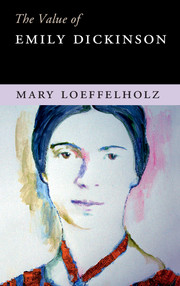Introduction
Published online by Cambridge University Press: 05 June 2016
Summary
Emily Dickinson's writing remains valuable to a wide range of readers today. This I know because my first-generation Kindle™ tells me so; when it goes to sleep, its electronic ink every so often morphs into her image, surfacing in the screensaver's rotation of canonical authors along with the likenesses of Charlotte Brontë, James Joyce, John Milton, Sir Thomas More, John Steinbeck, Shakespeare, Mark Twain, and Virginia Woolf.
If I query my reading machine about what Dickinson is being valued for, though, matters become more complicated. The Dickinson presented to readers through the Kindle's screen has been retouched on multiple dimensions. The image's hyperfeminine lace ruff, curly hair, and heavy eyeliner are crude twentieth-century fabrications drawn onto the single indisputably authenticated daguerreotype likeness that remains of Dickinson, taken in 1847 – she was then just over sixteen years of age – now preserved in the Jones Library of Amherst College. A reader disconcerted by Dickinson's extreme Kindle makeover could strike back with the “Emily Dickinson Historic Vinyl Wall Graphic Decal Sticker,” also available from Amazon.com – an imposing presence standing 60 inches tall, advertised as “Great for Parties.” Emily Dickinson as icebreaker? This unlikely version of Dickinson faithfully reproduces the flat hair and unadorned facial features of the famous daguerreotype, but alters Dickinson's dress to reveal her arms and neck: a wall sticker she may be but a wallflower she must not be, cost her image what it may in historical accuracy.
Less imposing but no less retouched are the Kindle store's most popular versions of Dickinson's writings: freely available digital transcriptions (made by volunteers in the Gutenberg Project) of the first, posthumously published volumes of Dickinson's poetry, edited by Thomas Wentworth Higginson and Mabel Loomis Todd and now in the public domain. Like the Kindle screensaver image, the writings in Poems of Emily Dickinson (edited by Higginson and Todd, 1890), Poems of Emily Dickinson, Second Series (Higginson and Todd, 1891), and Poems of Emily Dickinson, Third Series (edited by Todd on her own, 1896) were altered for public circulation, well ahead of their later migration into digital format: their spelling and punctuation altered to conform to late nineteenth-century norms, their stanza forms regularized, they appeared under titles (“The Secret,” “The Lonely House”) and in thematic groups (“Life,” “Love”) never assigned them by Dickinson herself.
- Type
- Chapter
- Information
- The Value of Emily Dickinson , pp. 1 - 10Publisher: Cambridge University PressPrint publication year: 2016

